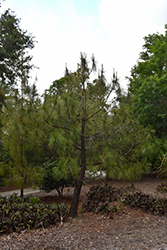It's all about ...
plants

Height: 80 feet
Spread: 50 feet
Sunlight:
![]()
Hardiness Zone: 9a
Other Names: syn. Pinus pseudostrobus var. estevezii
Description:
An excellent selection that develops an upright rounded habit and horizontal, curving branches over time; young bark is smooth and reddish brown, turning gray and scaly; long, soft needles are blue-green; attractive brown cones persist for up to 2 years
Ornamental Features
Smooth-bark Mexican Pine is primarily valued in the landscape for its decidedly oval form. It has bluish-green evergreen foliage. The large needles remain bluish-green throughout the winter. The brown fruits are held in cones from early winter to late fall. The fruit can be messy if allowed to drop on the lawn or walkways, and may require occasional clean-up. The smooth brown bark and brick red branches are extremely showy and add significant winter interest.
Landscape Attributes
Smooth-bark Mexican Pine is a multi-stemmed evergreen tree with a shapely oval form. Its average texture blends into the landscape, but can be balanced by one or two finer or coarser trees or shrubs for an effective composition.
This is a relatively low maintenance tree. When pruning is necessary, it is recommended to only trim back the new growth of the current season, other than to remove any dieback. It is a good choice for attracting birds and squirrels to your yard. It has no significant negative characteristics.
Smooth-bark Mexican Pine is recommended for the following landscape applications;
- Accent
- Shade
- Naturalizing And Woodland Gardens
Planting & Growing
Smooth-bark Mexican Pine will grow to be about 80 feet tall at maturity, with a spread of 50 feet. It has a high canopy of foliage that sits well above the ground, and should not be planted underneath power lines. As it matures, the lower branches of this tree can be strategically removed to create a high enough canopy to support unobstructed human traffic underneath. It grows at a fast rate, and under ideal conditions can be expected to live for 80 years or more. This is a self-pollinating variety, so it doesn't require a second plant nearby to set fruit.
This tree should only be grown in full sunlight. It is very adaptable to both dry and moist growing conditions, but will not tolerate any standing water. It is considered to be drought-tolerant, and thus makes an ideal choice for xeriscaping or the moisture-conserving landscape. This plant should not require much in the way of fertilizing once established, although it may appreciate a shot of general-purpose fertilizer from time to time early in the growing season. It is not particular as to soil type or pH. It is somewhat tolerant of urban pollution. This species is not originally from North America.
This plant is not reliably hardy in our region, and certain restrictions may apply; contact the store for more information.
